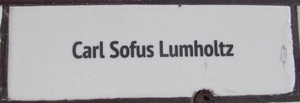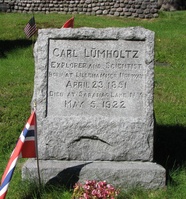 A brick at the Saranac laboratory has been dedicated in the name of Carl Sofus Lumholtz by Historic Saranac Lake.
A brick at the Saranac laboratory has been dedicated in the name of Carl Sofus Lumholtz by Historic Saranac Lake.
 Carl Sofus Lumholtz
Carl Sofus Lumholtz  Carl Sofus Lumholtz tombstone in Pine Ridge Cemetery
Carl Sofus Lumholtz tombstone in Pine Ridge Cemetery
Born: 1851, Faberg (Lillehammer), Norway
Died: May 4, 1922, in Saranac Lake
Carl Sofus Lumholtz was a Norwegian discoverer and ethnographer known for his field research and ethnographic publications on the indigenous cultures of Australia and central Mexico. He was a founding member of the Explorers Club, an organization established in 1905 to promote exploration and scientific field work.
On December 16, 1921, Dr. Francis B. Trudeau saw Carl Lumholz (sic), whose last address was Hotel Penn., N.Y.C. Advanced T.B. was present. His address in Saranac Lake was 50 Baker Street. At age 64, he was much older than the typical patient in Saranac Lake. 1
Lumholtz spent the last few months of his life at the Williams Cottage in an unsuccessful attempt to cure his tuberculosis, under the care of Dr. Francis Berger Trudeau and Dr. Charles C. Trembley. For seventy years after his death, his grave in the Pine Ridge Cemetery went largely unnoticed until, in 1992, the Norwegian Broadcasting Company visited Saranac Lake to wrap up a chronicle of his life. Parks in Queensland and Mexico have been named in his honor.
 Bengt Kristiansen, camera operator for a Norwegian Broadcasting Company film crew, shoots the grave site of Carl Lumholtz for a documentary about the scientist. Adirondack Daily Enterprise, March 3, 1993 Adirondack Daily Enterprise, March 6, 1993
Bengt Kristiansen, camera operator for a Norwegian Broadcasting Company film crew, shoots the grave site of Carl Lumholtz for a documentary about the scientist. Adirondack Daily Enterprise, March 3, 1993 Adirondack Daily Enterprise, March 6, 1993
Film crew chronicles life of Norwegian explorer
By KATHLEEN HALEY
Enterprise Staff Writer
(Editor's note: This story was compiled through the research of Historian Edna Finn.)
SARANAC LAKE — An unadorned, simple tombstone in Pine Ridge Cemetery marks the final resting place of a man who traversed unexplored regions of his time, made friends with headhunters and became recognized as a national hero in his homeland of Norway.
Carl Lumholtz, explorer and researcher, found fame in his extensive work but died without family or notoriety during the Saranac Lake curing days of the 1920s.
Lumholtz extensively researched the tribes, cultures and environments of areas in Mexico, southwestern United States, Borneo and Australia throughout a 40-year span in the late 1800s and early 1900s.
Until recently his Saranac Lake grave has gone unrecognized, but now through the work of Historian Edna Finn and the Norwegian Broadcasting Corporation, the grave will soon be marked by a Norwegian flag and a page in the history journals of Saranac Lake.
Finn became aware of the prestigious explorer's days in Saranac Lake through a teacher from Lillehammer, Norway, who traveled with his son to the village to re-trace the steps of Lumholtz in this country. Christopher Hoen and his son, Kristoffer, visited Saranac Lake in October of 1992 and toured the area with Finn to see where Lumholtz lived for a time and then died.
The curing house still stands at 50 Baker St., where Lumholtz spent his last days and died on May 5, 1922, at the age of 71 from pulmonary tuberculosis. (Biographies list Lumholtz's death as caused by a recurrence of a tropical fever but his death certificate, located by Finn, lists TB as the cause.)
Finn was contacted in December of 1992 by the Norwegian Broadcasting Corporation of Oslo, when officials told her they would be doing a television documentary about Lumholtz. Finn said that for Norwegians, Lumholtz is on the level of the explorer David Livingstone.
The Norwegian camera crew arrived Sunday, Feb. 28 and took several location shots, including some at Pine Ridge Cemetery, where he is buried. The crew was forced to snowshoe in to film. The crew which had arrived from Australia, will next be heading to Mexico for more film about the places where Lumholtz studied.
The documentary will highlight Lumholtz's life and death from his birth in 1851 in Norway and his travels throughout the world until his death in Saranac Lake.
Lumholtz was born on April 23, 1851 in Lillehammer. His father had wanted him to study theology and enter the priesthood but Carl himself wanted to study botany and zoology. However, as a dutiful son, he started to study for the priesthood and unfortunately had a nervous breakdown when trying to complete his studies.
For therapy, Lumholtz started to study and collect specimens in the mountains of central Norway for at the University of Christiania (Oslo) zoological museum. He took a second degree in natural sciences and then took up an offer from a professor, who asked him to collect specimens in Australia for the museum.
Lumholtz stayed in Australia for four years to further study aboriginal life. In his writings, My Life of Exploration, Lumholtz speaks of his observations including the consistency of snakes and tree kangaroos eaten for meat, building shelter in cold weather and the discovery of new species of animals.
Although some researchers of Lumholtz's study said his work showed some prejudice and contempt for the aborigines through his remarks about the aborigines being uncivilized and lazy, it is also said he revealed the humanity of the aborigines and his own empathy with living their life.
His next expeditions took him to Central America with the backing of philanthropists such as Andrew Carnegie, J. Pierpont Morgan and the Vanderbilts and organizations such as the American Museum of Natural History and the American Geographical Society.
At this time he made his home base in New York City between periodic visits to Norway. Lumholtz made four expeditions to Mexico and the southwestern regions of the United States. During his first expedition, he studied the ruins of past civilizations at Casas Grandes in North Chihuahua. He discovered new species and unearthed over 500 pieces of pottery. On further expeditions, he studied the cave-dwelling Tarahumare Indians as well as the Tepehuanes and the Tubares. His work on those group was presented at the world's fair in Chicago in 1893, where he also lectured on the cave dwellers of the Sierra Madre.
Lumholtz's primary concern was to establish a record of the cultures and he went back on other expeditions to confirm answers to his questions with other anthropologists. He surmised that some of the tribes he visited remained the same since the time of the Medieval Spanish explorer Cortez.
At the age of 63, Lumholtz set out to study New Guinea with backing from the Norwegian government. However, while traveling through Dutch Borneo in the Pacific, World War I broke out and me Governor-General could not guarantee his safety while traveling.
So, he remained to travel in Borneo which he wrote about in his publication Through Central Borneo. He himself claimed to be the first explorer to "put the head hunters of Borneo in the right light before the civilized world."
Although there were other researchers before and after him, he wrote in English and opened the research up to a wider English speaking audience.
About the Dayak head-hunters in Central Borneo, he explained that although it seemed like a bizarre and gruesome custom, to the natives it was a way to protect against evil spirits.
The head-hunters cut off their captured enemies' heads and if the heads were treated well, they became a guardian for die tribe. As in most east Asian cultures, their beliefs held that this life was no different from the next, so the soul is not lost from one life to another and remains in the head.
After his trip to Borneo, at the age of 70, he traveled to Norway and then the United States to secure funds for an expedition to New Guinea.
It was during his time in the U.S. when it was believed he contracted TB and put off his plans for the New Guniea expedition.
Little is known about Lumholtz's stay in Saranac Lake but it seems likely he died with no relatives present. From records of the Fortune Funeral Home, it showed he had been in Saranac Lake for four months prior to his death and settled in the United States for 15 years. His attending physicians had been Dr. Francis Trudeau and Dr. Charles Tremblay. Church services were held at St. Luke's Episcopal Church with the Rev. Elmer Pliny Miller.
Since his death and until now 70 years later, his grave has gone unnoticed but since his life and times have been noted as more than ordinary, the grave will be marked in the spring by a small flag given to Finn by the Norwegian filming crew.
Lumholtz, who spent little of his life in his home country and never married, appeared to biographers as a loner who enjoyed communing with nature and natives — a free spirit now roaming among the natives of die Adirondacks' Pine Ridge Cemetery.
(Additonal references included Through Central Borneo, by Carl Lumholtz, with an introduction by Victor King and My Life of Exploration, Natural History, by Carl Lumholtz, May-June 1921.)
Sources:
- Carl Sofus Lumholtz on Wikipedia.
- Adirondack Daily Enterprise, May 17, 1996
| Jardin Botanico | |
| Instituto de Biologia | |
| Universidad Nacional Autonoma de Mexico | |
| Apdo. Post. 70-614 | |
| 04510 Mexico, DF | |
| MEXICO | |
| 22 Sept. 1993 |
Mrs. Natalie Leduc 143 Lake St. Saranac Lake, NY 12983 EUA
Dear Mrs. Leduc,
While passing through Saranac Lake, I revisited the grave site of Dr. Carl Lumholtz and was deeply moved to see that his body's final resting place had been planted to pansies and begonias. Through the recommendation of a friend of my dear friend, Greenleaf Chase, I obtained your name but you were not in. I eventually talked with Mrs. Edna Finn who filled me in on the recent history. I understand that you are personally responsible of caring for Dr. Lumholtz' grave.
As a person who has followed in his footsteps (which, in part, started in the Saranac Lake region where his ended), I want to express my appreciation for your efforts and hope that it will continue. As I mentioned to Mrs. Finn, I will see if I can obtain plants from the Sierra Madre Occidental of Mexico for planting at his grave site. At the moment, I am trying to locate seeds of Lumholtz pine. I enclose photocopies its description. I would appreciate your help in contacting the Pine Ridge Cemetery authorities to see what permission would be needed. If the pine tree is not acceptable, I can look for an appropriate perennial herb. If the seeds are available and the permission granted, I will contact friends at the College of Forestry at Syracuse to see if they, can germinate the seeds and send saplings to you. If there are extra, perhaps the Saranac Lake Parks Department, the owners of 50 Baker Street (where Lumholtz lived) and others would be in interested in growing the pine tree.
Sincerely
Robert A. Bye, Jr. (Ph. D.) Investigador Titular Director
Comments
Footnotes
1. "Report of a Case of Tuberculosis," on file in the Adirondack Collection, Saranac Lake Free Library.



